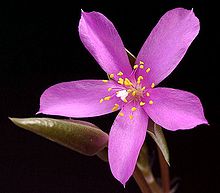| Anacampseros | |
|---|---|
 | |
| Anacampseros rufescens | |
| Scientific classification | |
| Kingdom: | Plantae |
| Clade: | Tracheophytes |
| Clade: | Angiosperms |
| Clade: | Eudicots |
| Order: | Caryophyllales |
| Family: | Anacampserotaceae |
| Genus: | Anacampseros L. |
| Species | |
See text | |


AnacampserosL. is a genus comprising about a hundred species of small perennial succulent plants native to Southern Africa, Ethiopia and Latin America. The botanical name Anacampseros is an ancient one for herbs supposed to restore lost love.
Contents
The Australian species Grahamia australiana was at one time included in the genus Anacampseros, but the entire genus now is regarded as Southern African, and no longer includes any Australian representatives.






